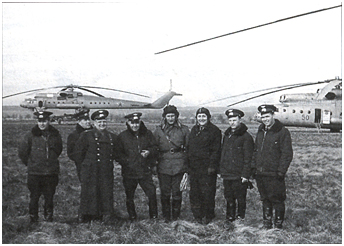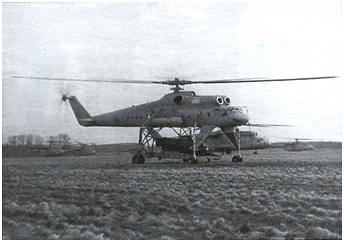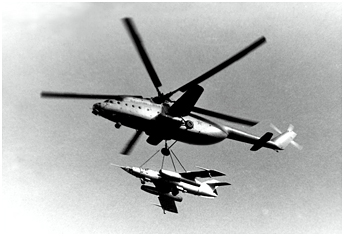
 Le drapeau du 23ème Régiment d'aviation à long rayon d'action de la garde (23.GAP DD)
dont était issu le 239.OGVP photographié à Brandis au cours des années 60. © DR.
Le drapeau du 23ème Régiment d'aviation à long rayon d'action de la garde (23.GAP DD)
dont était issu le 239.OGVP photographié à Brandis au cours des années 60. © DR.
The 23rd Guards Long-Range Aviation Regiment (23.GAP DD) flag seen at Brandis during the 1960s. The 239.OGVP stemmed from that unit.
© DR.
The largest of the Soviet helicopters based in Germany was certainly the Mil Mi-6 "Hook." In the late 1980s, three different versions of this helicopter
were operational within the units of the Armeiskaya Aviatsiya based in the GDR. They did most of the heavy transport by helicopter and a handful of them
were modified into airborne command posts.
Now decommissioned and partially replaced in Russia by the Mi-26 "Halo," the Mi-6 was an old machine whose first flight dated back to 1957.
The NATO designation "Hook" was certainly appropriate as this heavy twin-engine helicopter could carry 9 tons of cargo under sling or 12 tons inside its cargo hold.
Twenty-six improved Mi-6A "Hook-A" were on strength with two of the four squadrons of the 239 "Belgorodskiy" OGVP
(or Otdel'nyy Gvardeiskiy Vertoletnyy Polk - 'Belgorod' Separate Guards Helicopter Regiment) (1)
at Oranienburg - a base with a name sadly famous (2) that was immediately
adjacent to the north Berliner ring - at the time of withdrawing from Germany.
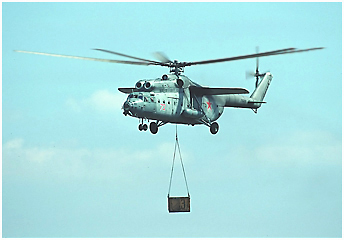
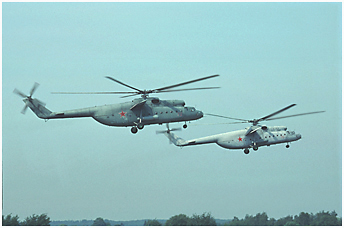 In the GSFG order of battle, this regiment compensated for the absence of a second regiment of tactical transport aircraft within the 16.VA.
It was also under the direct control of this Air Army. The 239.OGVP moved from Siauliai in Lithuania to Fürstenwalde in November 1959.
The regiment was then equipped with Mi-4 "Hound." It moved to Brandis in 1962, where the Mi-6 "without suffix" joined the ranks of the unit the same year.
The regiment took part to Operation "Danube" (the invasion of Czechoslovkia) in 1968. The last Mi-4s left Brandis in 1971, whereas the new Mi-8s arrived in 1969.
As for Mi-6, they gradually gave way to Mi-6A around 1971. The unit finally moved to Oranienburg from 1977 on.
In the GSFG order of battle, this regiment compensated for the absence of a second regiment of tactical transport aircraft within the 16.VA.
It was also under the direct control of this Air Army. The 239.OGVP moved from Siauliai in Lithuania to Fürstenwalde in November 1959.
The regiment was then equipped with Mi-4 "Hound." It moved to Brandis in 1962, where the Mi-6 "without suffix" joined the ranks of the unit the same year.
The regiment took part to Operation "Danube" (the invasion of Czechoslovkia) in 1968. The last Mi-4s left Brandis in 1971, whereas the new Mi-8s arrived in 1969.
As for Mi-6, they gradually gave way to Mi-6A around 1971. The unit finally moved to Oranienburg from 1977 on.
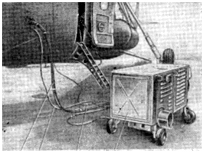
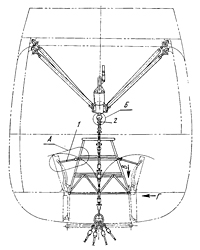 The Mi-6A, which appeared in 1971, had an airframe with a longer lifetime and improved avionics.
The AP-31 autopilot of the Mi-6 (the same as on the Mi-4) was so inappropriate that its use was simply forbidden...
The 'A' version benefited from the new AP-34 autopilot. The hydraulic system was also modified and the variable-incidence wings
of the Mi-6 (the pilot reduced their angle of attack during an autorotation landing) were now fixed.
Mi-6 and Mi-6A were considered to be two different helicopters and the two different versions rarely were mixed within the same squadron.
However, there was no external difference between the two versions, at least at first sight. The Mi-6 carried aboard an AI-8 APU trailer
(above) necessary to start the engines when deployed in the field. This APU was permanently mounted on the inside face of the left clam-shell
door of the Mi-6A. Thus, this new model had two circular holes drilled in that door for the AI-8 oil radiator and exhaust.
The helicopters of the latest Mi-6 series, however, were upgraded with a fixed AI-8. The Mi-6A could carry up to 90 troops (65 previously)
or carry a sling load of nine tons (sketch of the hook system at right).
The Mi-6A, which appeared in 1971, had an airframe with a longer lifetime and improved avionics.
The AP-31 autopilot of the Mi-6 (the same as on the Mi-4) was so inappropriate that its use was simply forbidden...
The 'A' version benefited from the new AP-34 autopilot. The hydraulic system was also modified and the variable-incidence wings
of the Mi-6 (the pilot reduced their angle of attack during an autorotation landing) were now fixed.
Mi-6 and Mi-6A were considered to be two different helicopters and the two different versions rarely were mixed within the same squadron.
However, there was no external difference between the two versions, at least at first sight. The Mi-6 carried aboard an AI-8 APU trailer
(above) necessary to start the engines when deployed in the field. This APU was permanently mounted on the inside face of the left clam-shell
door of the Mi-6A. Thus, this new model had two circular holes drilled in that door for the AI-8 oil radiator and exhaust.
The helicopters of the latest Mi-6 series, however, were upgraded with a fixed AI-8. The Mi-6A could carry up to 90 troops (65 previously)
or carry a sling load of nine tons (sketch of the hook system at right).
Flying cranes
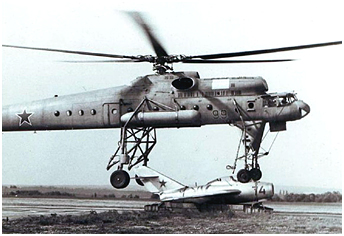 Some Mi-10 "Harke" were observed and photographed in the GDR. Unfortunately, few reliable information about them are known.
Testimonies and photographs report their presence in Brandis for a short period from the late sixties - some say 1968, others 1965.
If their incorporation into the 239.OGVP is almost certain, their presence at Brandis is logical from a logistical standpoint (3).
The Mi-10 had indeed been developed on the basis of the Mi-6, with which it shared a number of components including the rotors, their transmission systems and its
two Solov'yev D-25V engines of 5500 hp.
A witness recalls: "In 1971 or 1972, I saw three helicopters at Brandis. They were all equipped with a transport platform. They were parked at the end of the airfield,
toward Altenbach. A MiG-21 fuselage was near the maintenance hangar. It seems that this MiG-21 was used for training with the Mi-10" (4).
Some Mi-10 "Harke" were observed and photographed in the GDR. Unfortunately, few reliable information about them are known.
Testimonies and photographs report their presence in Brandis for a short period from the late sixties - some say 1968, others 1965.
If their incorporation into the 239.OGVP is almost certain, their presence at Brandis is logical from a logistical standpoint (3).
The Mi-10 had indeed been developed on the basis of the Mi-6, with which it shared a number of components including the rotors, their transmission systems and its
two Solov'yev D-25V engines of 5500 hp.
A witness recalls: "In 1971 or 1972, I saw three helicopters at Brandis. They were all equipped with a transport platform. They were parked at the end of the airfield,
toward Altenbach. A MiG-21 fuselage was near the maintenance hangar. It seems that this MiG-21 was used for training with the Mi-10" (4).
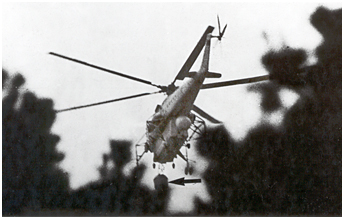
 Beside some Mi-10 "Harke-A" (i.e. the original version, different from the Mi-10K "Harke-B" with a short landing gear) transport helicopters, at least one special
Mi-10 was photographed in the GDR.
An experimental version intended for tracking enemy radio transmissions was also developed in 1966. The latter, designated Mi-10GR
Grebeshok (Cockscomb) carried a ventral container and two antennas housed in two thimble fairings, that were deployable
at the front and the back of this container. The fairings which housed two antennas associated with the
Grebeshok system, seemed similar to the deployable antenna of the Mi-8R, of which three or four exemplars were
identified in East Germany during the 1980s (> Link). There is nothing surprising about that,
since this variant of the Mi-8 carried a Grebeshok-5.
It seems that a single exemplar of that Mi-10 version was ever produced. The only known photo until recently of the Mi-10GR (above right) was part of a
series that was taken in the GDR in 1968 by the USMLM!
Unfortunately, there is no evidence of Soviet origin mentioning the presence of this particular helicopter in East Germany (5).
As for the transport Mi-10s, they left Brandis in 1972 or 1975 and moved to the Konotop maintenance center (ARZ).
The last operational Mi-10 were removed from the inventory of VVS in 1989.
Beside some Mi-10 "Harke-A" (i.e. the original version, different from the Mi-10K "Harke-B" with a short landing gear) transport helicopters, at least one special
Mi-10 was photographed in the GDR.
An experimental version intended for tracking enemy radio transmissions was also developed in 1966. The latter, designated Mi-10GR
Grebeshok (Cockscomb) carried a ventral container and two antennas housed in two thimble fairings, that were deployable
at the front and the back of this container. The fairings which housed two antennas associated with the
Grebeshok system, seemed similar to the deployable antenna of the Mi-8R, of which three or four exemplars were
identified in East Germany during the 1980s (> Link). There is nothing surprising about that,
since this variant of the Mi-8 carried a Grebeshok-5.
It seems that a single exemplar of that Mi-10 version was ever produced. The only known photo until recently of the Mi-10GR (above right) was part of a
series that was taken in the GDR in 1968 by the USMLM!
Unfortunately, there is no evidence of Soviet origin mentioning the presence of this particular helicopter in East Germany (5).
As for the transport Mi-10s, they left Brandis in 1972 or 1975 and moved to the Konotop maintenance center (ARZ).
The last operational Mi-10 were removed from the inventory of VVS in 1989.
Versatile Mi-6s
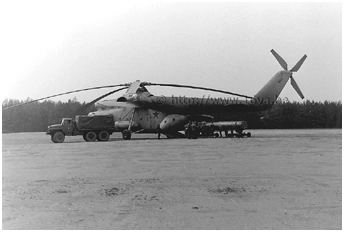
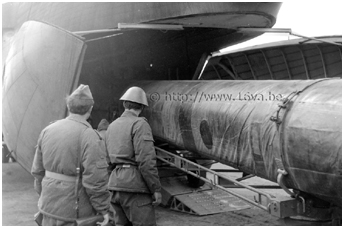 Transporting surface-to-surface missiles by helicopter to increase the mobility of the missile forces was envisioned in 1960.
Mi-6 helicopters would be fitted with a winch suitable for missile loading and additional attachment points.
An Mi-6PRTBV (Podvizhnaya Raketno-Tekhnicheskaya Baza Vertoletnogo tipa or Mobile Heliborne Missile
Technical Base) as it was called, could carry short-range tactical missiles such as the "Scud" or strategic missile warheads to launch sites. However, this Mi-6 version was abandoned.
Another concept was to carry the missiles with their launchers to inaccessible sites to launch a surprise attack. It was necessary to design smaller and autonomous launchers for that purpose.
Initial tests were conducted with a 9K52 Luna-M "FROG-7" system later renamed 9K53 Luna-MV (V for Vertoletnyy or helicopter) after modifications.
The 9K72 El'brus SS-1C "Scud-B" system and its R-17 / 8K14 missile was then modified and designated the 9K73 (R-17V / 8K114 missile with a 9P114 self-propelled launcher).
Only one Mi-6 would have been modified to transport these experimental complexes. The latter was designated Mi-6RVK (Raketno-Vertoletnyy Kompleks or missile-helicopter complex).
However, the trials conducted by the army in 1965 with two 9K73 systems proved inconclusive and the complex did not reach operational status. Nevertheless, transporting missiles
continued as shown in the photos above left and right. They were taken in 1989 in the Wittenberg area as part of a "Monsun" rapid missile transport exercise, in this case an R-17 rocket -
with an inert warhead - that was delivered to a NVA unit by an Mi-6A of the 239.OGVP (> Link).
Transporting surface-to-surface missiles by helicopter to increase the mobility of the missile forces was envisioned in 1960.
Mi-6 helicopters would be fitted with a winch suitable for missile loading and additional attachment points.
An Mi-6PRTBV (Podvizhnaya Raketno-Tekhnicheskaya Baza Vertoletnogo tipa or Mobile Heliborne Missile
Technical Base) as it was called, could carry short-range tactical missiles such as the "Scud" or strategic missile warheads to launch sites. However, this Mi-6 version was abandoned.
Another concept was to carry the missiles with their launchers to inaccessible sites to launch a surprise attack. It was necessary to design smaller and autonomous launchers for that purpose.
Initial tests were conducted with a 9K52 Luna-M "FROG-7" system later renamed 9K53 Luna-MV (V for Vertoletnyy or helicopter) after modifications.
The 9K72 El'brus SS-1C "Scud-B" system and its R-17 / 8K14 missile was then modified and designated the 9K73 (R-17V / 8K114 missile with a 9P114 self-propelled launcher).
Only one Mi-6 would have been modified to transport these experimental complexes. The latter was designated Mi-6RVK (Raketno-Vertoletnyy Kompleks or missile-helicopter complex).
However, the trials conducted by the army in 1965 with two 9K73 systems proved inconclusive and the complex did not reach operational status. Nevertheless, transporting missiles
continued as shown in the photos above left and right. They were taken in 1989 in the Wittenberg area as part of a "Monsun" rapid missile transport exercise, in this case an R-17 rocket -
with an inert warhead - that was delivered to a NVA unit by an Mi-6A of the 239.OGVP (> Link).
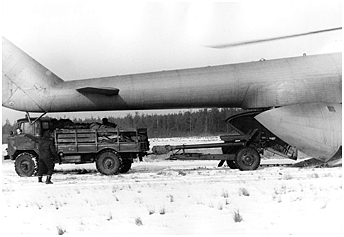
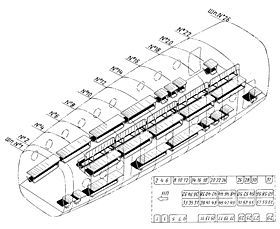 In the 1970s, Mi-6s began to be modified to carry out parachute landings.
Cables for the parachute static lines were installed in the cargo compartment. A Mi-6A equipped with folding seats (at right) could accommodate sixty-one paratroopers.
The "Hook" of the 239.OGVP went to airfields and training ranges like the one at Redlin near the Retzow Air/Ground Gunnery Range, to embark and drop
paratroopers of the Separate Airborne Assault Brigades.
Since all the entrance doors of the helicopter opened outwards, it was impossible to open them or keep them open when in the air.
Prior to dropping paratroopers, the rear doors were removed and a folding tubular structure was blocking the opening so that no one would accidently fall out.
When flights were completed, the doors had to be put back on in order to close the cabin.
The rear doors were later modified to open inwards, making it possible to do this in flight. They were manufactured without blisters.
In the 1970s, Mi-6s began to be modified to carry out parachute landings.
Cables for the parachute static lines were installed in the cargo compartment. A Mi-6A equipped with folding seats (at right) could accommodate sixty-one paratroopers.
The "Hook" of the 239.OGVP went to airfields and training ranges like the one at Redlin near the Retzow Air/Ground Gunnery Range, to embark and drop
paratroopers of the Separate Airborne Assault Brigades.
Since all the entrance doors of the helicopter opened outwards, it was impossible to open them or keep them open when in the air.
Prior to dropping paratroopers, the rear doors were removed and a folding tubular structure was blocking the opening so that no one would accidently fall out.
When flights were completed, the doors had to be put back on in order to close the cabin.
The rear doors were later modified to open inwards, making it possible to do this in flight. They were manufactured without blisters.
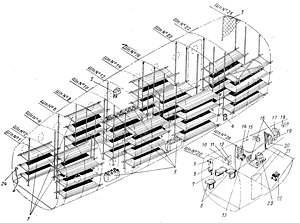
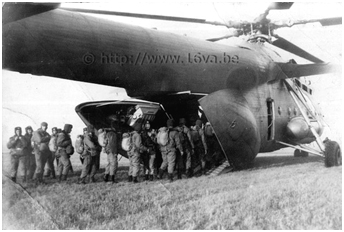 Forty-one stretchers and medical support equipment could be installed aboard a Mi-6 in medevac configuration (at left).
Forty-one stretchers and medical support equipment could be installed aboard a Mi-6 in medevac configuration (at left).
There was a "Hook" model, which was specially modified to refuel tanks and other vehicles on the front lines.
The Mi-6TZ-SV (Toplivozapravshchik-Sukhoputnyye Voyska or refueller for ground forces) that was based on the Mi-6 and Mi-6A (1973)
airframes, carried inside its cargo compartment four fuel tanks that were similar to the standard Mi-6 external fuel tanks.
These tanks with a capacity of 2,250 liters were mounted in adpated cradles and were used to store fuel for the vehicles (6).
A pump station (the tanks were obviously not linked to the fuel system of the helicopter)
and two reels of hose were located in the rear of the cargo compartment. The latter were mounted perpendicular to the rear side doors.
The nozzles were very similar to those found at a gas station.
A control panel was located to the right of the rear cargo compartment landing door.
There were also two racks for 20-liter oil jerry cans attached to the clam shell-doors. The TZ variant could carry any kind of fuel.
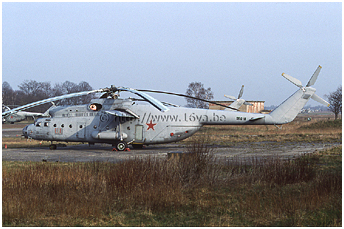 It was possible to remove this equipment at the unit level so the Mi-6s could be employed as cargo helicopters (and vice versa). The basic layout of a Mi-6TZ (electrical wiring
modification, additional plumbing etc), however, should be done at a repair plant (ARZ). According to the testimony of Valeriy Belichenko, an Mi-6/Mi-6A pilot of the 239.OGVP
from 1983 to 1989, there were no Mi-6TZ at Oranienburg during the time he was assigned to that unit.
However, if Mi-6TZ were externally similar to their transport colleagues, the Mi-6A N°01 (s/n 0601V) based in Oranienburg in the early
nineties, was uncommon. Examination of different pictures of this machine, which are available in the photo gallery
(for which there is a link at the bottom of this page, and at left), reveals the presence of an external yellow pipe under the rear side doors
on each side of the fuselage. These pipes were connected to a group of internal tanks under the floor of the Mi-6, then part of the eleven internal standard tanks
that were mounted inside any transport Mi-6 variant. These pipes were connected to the pumps for refuelling the vehicles, providing a supplementary storage capacity
to this former Mi-6TZ-SV.
It was possible to remove this equipment at the unit level so the Mi-6s could be employed as cargo helicopters (and vice versa). The basic layout of a Mi-6TZ (electrical wiring
modification, additional plumbing etc), however, should be done at a repair plant (ARZ). According to the testimony of Valeriy Belichenko, an Mi-6/Mi-6A pilot of the 239.OGVP
from 1983 to 1989, there were no Mi-6TZ at Oranienburg during the time he was assigned to that unit.
However, if Mi-6TZ were externally similar to their transport colleagues, the Mi-6A N°01 (s/n 0601V) based in Oranienburg in the early
nineties, was uncommon. Examination of different pictures of this machine, which are available in the photo gallery
(for which there is a link at the bottom of this page, and at left), reveals the presence of an external yellow pipe under the rear side doors
on each side of the fuselage. These pipes were connected to a group of internal tanks under the floor of the Mi-6, then part of the eleven internal standard tanks
that were mounted inside any transport Mi-6 variant. These pipes were connected to the pumps for refuelling the vehicles, providing a supplementary storage capacity
to this former Mi-6TZ-SV.
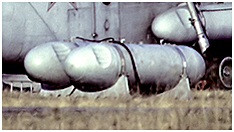 Les réservoirs externes des Mi-6 étaient également utilisés en soute
pour ravitailler les véhicules (Mi-6TZ) ou afin d'augmenter l'autonomie de l'hélicoptère. Ces réservoirs, montés sur un bâti adapté, étaient aisément démontables comme illustré
ci-contre. © C.Brent.
Les réservoirs externes des Mi-6 étaient également utilisés en soute
pour ravitailler les véhicules (Mi-6TZ) ou afin d'augmenter l'autonomie de l'hélicoptère. Ces réservoirs, montés sur un bâti adapté, étaient aisément démontables comme illustré
ci-contre. © C.Brent.
The external fuel tanks of the Mi-6 could be carried inside the cargo compartment in order to refuel vehicles (Mi-6TZ) or to augment the range of the
helicopter. They were mounted in a cradle that could be easily removed, as illustrated here.
© C.Brent.
However, when we were able to photograph this helicopter, it was equipped with special side doors at the back to drop paratroopers. That seems to indicate that it was no
longer used as a refueler at that time. On the other hand, given the testimony cited above, it is very likely that this "Hook" was delivered to the 239.OGVP without its refueling equipment.
In addition, Valeriy Belichenko informed us about the presence of a Bort number 01 cargo variant while he was serving at Oranienburg that was probably a different machine.
Moreover, the range of the Mi-6/Mi-6A transport versions could be increased by carrying in the hold the same fuel tanks of the TZ version that were, you will recall, of the same
type as the external side tank of the Mi-6. Here, these two fuel tanks were connected to the internal fuel circuitry of the helicopter.
notes
(1)
When the regiment arrived in East Germany in 1959, it was designated "Guards Helicopter Regiment."
The final unit designation was adopted in 1960.
The 3.TBAP (Heavy Bombardment Aviation Regiment), established in 1938, later was redesignated the 3.AP DD. It then became the 23rd Guards Long-Range Aviation Regiment
(23.GAP DD) on 18 Septebmer 1943, eventually to become the 239.GBAP (Guards Bombardment Aviation Regiment) on 26 December 1944.
(2)
Oranienburg, a small town on the outskirts of the Greater Berlin, even before World War II housed
a detention camp for political prisoners, Oranienburg-Sachsenhausen. The latter was transformed later into a concentration camp.
By a phenomenon of selective memory of which some of our contemporaries are particularly fond, the evocation of
Sachsenhausen camp among some of the surrounding population is a reminder of the martyrdom of German prisoners of war
detained there by Soviet forces...
(3)
According to a unique testimony, two helicopters were also based at Dresden-Hellerau - were they detached from the unit based in Brandis or just passing through?
(4)
Valeriy Belichenko mentions the presence of MiG-15, MiG-21 and Yak-27 in Brandis, also used to train the Mi-6 crews.
(5)
Another electronic variant of the Mi-10 was designated Mi-10PP.
Work on this electronic countermeasures version of the Mi-10 began in 1966. The development of the Mi-10PP was completed four
years later. About two dozen Mi-10 were converted to the Mi-10PP during the mid-seventies in Rostov and Konotop. The Mi-10PP was
designed to support Frontal Aviation combat actions by jamming enemy ground-based radars.
These particular Mi-10s were carrying a Step ST-9000 container weighting 7125 kg suspended on hydraulic locks under their bellies.
Located inside were three Buket jammers acting against missile acquisition and guidance radars, causing radar clutter, as were eight Fasol'
repeater transmitters to create simulated jamming (when operating in the "pull-off" mode, several dummy blips immediately appeared on the operator's radar screen).
Work stations for the EW operators were set up in the helicopter cargo compartment, with a system of pod-mounted power supplies also installed there.
Although these jamming systems, also used on different Soviet aircraft models, had a reputation for being temperamental, they proved very effective in the hands of
a competent crew. Some testimonies mention strong vibrations when the container was transported. No information about the possible deployment of such helicopters in the GDR exist.
(6)
You can download an interesting video 30-Mb in size showing a Kazakh Mi-26TZ in operation > here.
 |
The Mi-6 & Mi-10 > Part 2 |
 |
Plan du site - Sitemap |  |

